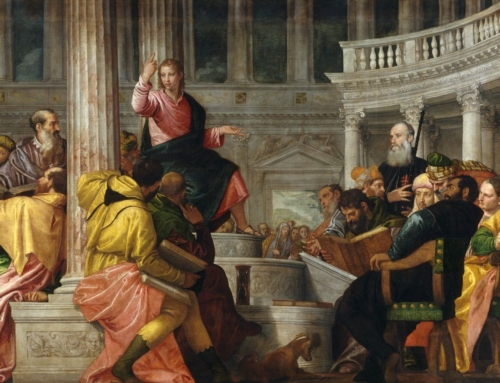From its beginning, the Christian faith understood itself as the fulfillment of the Jewish faith, the new and everlasting covenant that God established with man in order to draw all things to himself through Jesus Christ. Jesus instituted the Eucharist, the “source and summit of the Christian life” (Vatican II, Lumen gentium 11), at the traditional Jewish Passover meal with his Apostles on Holy Thursday. The Feast of Passover was a rich cultural context, within which the Jewish people were introduced to the significance of what Christ would do in the Eucharist. Passover recalled God’s saving intervention on behalf of his people to bring them forth out of slavery in Egypt. Several Fathers of the early church saw this as a foreshadowing of God’s salvation of all mankind from slavery to sin. Additionally, the Israelite people were protected by the blood of a lamb, which, as St. Paul points out, foreshadowed the sacrificial death of Jesus Christ, “our Passover lamb” (1 Cor. 5:7). Over the course of salvation history, God, in his wisdom, had prepared a people and developed a culture that conveyed truths about God that were immediately recognized by the Jewish people, but that also pointed toward a deeper and more profound truth – one that was revealed in Jesus Christ.
The Passover is a cultural touchstone par excellence by which to understand the sacrificial nature of the Holy Sacrifice of the Mass. Yet while the Jewish people were uniquely chosen and prepared by the Lord, there are rituals and celebrations embedded within many cultures that can be useful for understanding various truths of our faith. Today, in the United States, we celebrate another meal, Thanksgiving dinner, a uniquely American feast with its own historical context and meaning. From childhood, we hear that when our European ancestors came to the New World they faced sickness and food shortage, but God intervened to save them from starvation through the generosity of Native Americans, who shared their food and showed the early settlers how to live off the land. In celebration of God’s goodness to our forerunners, we annually celebrate Thanksgiving Day, when we gather with family around a feast and give thanks for all of our blessings.
As the Jewish Passover meal highlights the sacrificial nature of the Mass, I propose that our own Thanksgiving feast provides an American cultural reference to help us understand the celebratory and unitive aspects of the Mass.
First, there is the name itself. St. Paul uses a form of the word eucharistia when he describes Jesus’ institution of the Eucharist: “And when he had given thanks (Greek: eucharistésas or “eucharisted”), he broke it, and said, ‘This is my body which is for you. Do this in remembrance of me’” (1 Cor 11:24). By the end of the first century the Mass came to be known as the Eucharist. “Now as regards the Eucharist, give thanks after this manner…” (Didache 9:1). The Greek word eucharistia, which we translate Eucharist, means “giving thanks.” As we are reminded at every Mass, it is right and just to give thanks to the Lord our God.
Second, sharing a meal unites people in a certain communion. Far more than most meals, our Thanksgiving feast draws people from across the country to travel long distances to come together with their families, to share in a greater common unity. This is a step toward understanding the way in which the Eucharist brings us into a holy communion with God and with each other, or as the Catechism says, “communion in the divine life and the unity of the people of God” (CCC 1325). The Eucharistic feast is meant to unite all of humanity in Jesus Christ as sons and daughters of God. Like Thanksgiving dinner, the Eucharist brings together family – God’s family.
Third, as we give thanks to God for all that he has given us, this gratitude naturally overflows into generosity. We consider it a normal part of Thanksgiving to see churches, food pantries, and other local groups sharing with those in need, aware themselves that all that we have, we have received from God. Beyond material provisions there is a desire to share Thanksgiving itself. In a similar way, after we are nourished at Mass from the twofold table of the Word and the Eucharist, we want to share this thanksgiving, this eucharistia, with others.
The people of God are sent forth from Mass with the words, “Go and announce the Gospel of the Lord.” As D.T. Niles said, “Evangelization is just one beggar showing another beggar where to find bread.” Specifically, it is sharing the bread for which every human soul hungers, the Bread of Life, Jesus Christ.
And, feasting on this bread, our thanksgiving extends from the present into eternity. In the Book of Revelation we hear of a great multitude praising God in heaven: “It is in this eternal liturgy that the Spirit and the Church enable us to participate whenever we celebrate the mystery of salvation in the sacraments” (CCC 1139).
As we celebrate our Thanksgiving feast today, may we thank God for the Eucharistic feast to which he invites us in every Mass, where even now we participate in the eternal thanksgiving of the blessed in heaven. May we also, in a spirit of thanksgiving, go forth to invite as many people as possible, to join us in our eucharistia, so that we may be joined together with the great multitude of God’s family, enjoying the heavenly feast of the Lamb for all eternity.
✠






